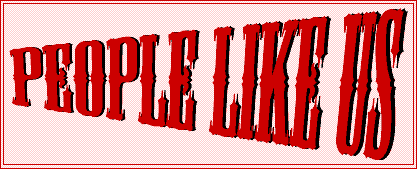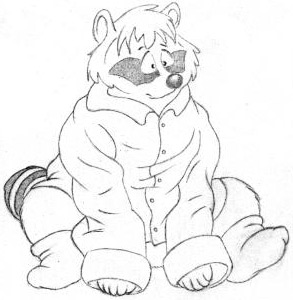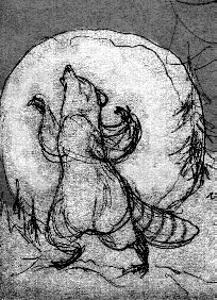
by Oren the Otter
©1999 Oren the Otter -- all rights reserved



by Oren the Otter
©1999 Oren the Otter -- all rights reserved


Hello, all you transformation addicts out there perusing the virtual magazine stand! I'm Oren the Otter, and it is my privilege this issue to introduce you to one of the most gifted artists to hit the transformation genre in recent years. I'm talking of course about Elwood Raccoon.
Oren: Thank you very much for agreeing to this interview. I'd like to start by saying that I think you are a very talented artist, especially the way you're able to capture so many different moods in your art. What was it that got you interested in doing transformation-themed art, and raccoons in particular?
Elwood: I'm always wondering how it must feel to live in another body. Drawing transformation art is just a natural progression from that. When I'm drawing I'm imagining myself in the position of the person I'm portraying. So before finding a whole community interested in transformation, my drawing was purely an exercise in fleshing out my fantasies, to make them seem more real. Now that's changed a little, as I'm not the only one looking at my drawings! Also, having lots of other TF art to look at has really inspired me to draw more and try out new ideas.
I've drawn lots of raccoon transformations as they are the animal I dream of becoming the most. My fascination with them goes way back to my childhood. I still entertain myself with fantasies of becoming other animals but raccoons have a special place in my heart. When I first found the transformation art out there, it seemed that raccoons had been almost completely overlooked. It was that more than anything that made me decide to create a page dedicated to raccoon transformation. I hope it'll encourage other people to try drawing them.
Oren: Speaking for myself, it certainly has gotten my creative juices flowing in a procyonid direction more than once. Your art is quite good, I must say. In a single transformation type, you have managed to capture dozens and dozens of different emotions, from liberation, to disappointment, to silliness, to terror, to quiet joy. I'm very curious to know how you've managed to cultivate and refine your skills so well. Do you have a formal art education?
Elwood: No, I've not had any art lessons to speak of. At school we just drew boxes, which isn't the greatest way to inspire your students. I dropped it as a subject as soon as I could. I was steered towards the sciences afterwards, which is where I got a half decent knowledge of animal and human anatomy. I got a lot of practice drawing afterwards from copying cartoon characters and doodling them in my notes during lectures. I think that helped loosen up my drawing and improve my sense of proportion. I like drawing real life animals too, copying them from photos. I'd strongly recommend doing that as it's taught me a lot about shading. Animal photos are also a great source of ideas.
Oren: Is it true that you're actually country singer Tom T. Hall's popular sidekick George the Basset disguised as a raccoon as part of an elaborate scheme to popularize certain breeds of coon-hunting dogs, thus enabling you to take over the world? No? Okay. Um...
As a student of the "mimic and doodle technique" (which I highly endorse) is there an artist or group of artists you would name as your primary examples for studying? I'm guessing that there's more than one, since you seem able to employ one style as easily as another.
Elwood: I've tried to emulate lots of artists, while trying not to settle on a single style. These include a number of animators and illustrators of children's books. I would recommend studying every transformation artist's work. To see what's been done before, how it was done, and what ideas have yet to be explored. I really like to see the rough sketches that some artists have posted. You can see how a drawing develops from those, whereas a fully inked and colored piece of art can be fairly imposing.
Oren: Solid advice. Any further sagely words of wisdom for our readers before we conclude?
Elwood: I can only reiterate the advice given in various art books I've read over the years, which is that if you want to improve your drawing you need to keep practicing daily. Even if it's just idle doodling. And above all, enjoy yourself!
Thank you, Elwood. A selection of Elwood's excellent pieces are available for viewing in the ART section of this issue. If you're interested in seeing more, I HIGHLY recommend a visit to the Raccoon Transformation Gallery.